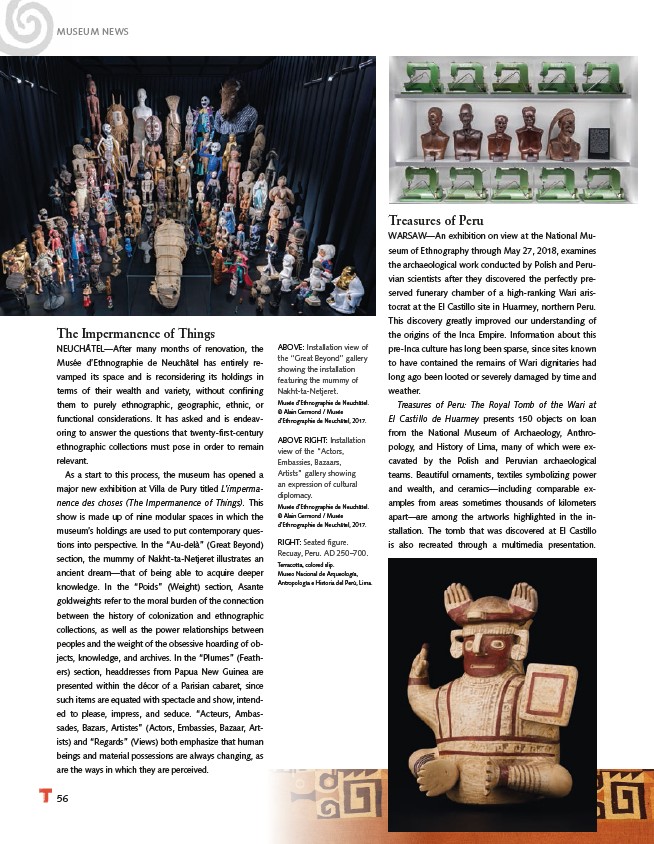
56
Treasures of Peru
WARSAW—An exhibition on view at the National Museum
of Ethnography through May 27, 2018, examines
the archaeological work conducted by Polish and Peruvian
scientists after they discovered the perfectly preserved
funerary chamber of a high-ranking Wari aristocrat
at the El Castillo site in Huarmey, northern Peru.
This discovery greatly improved our understanding of
the origins of the Inca Empire. Information about this
pre-Inca culture has long been sparse, since sites known
to have contained the remains of Wari dignitaries had
long ago been looted or severely damaged by time and
weather.
Treasures of Peru: The Royal Tomb of the Wari at
El Castillo de Huarmey presents 150 objects on loan
from the National Museum of Archaeology, Anthropology,
and History of Lima, many of which were excavated
by the Polish and Peruvian archaeological
teams. Beautiful ornaments, textiles symbolizing power
and wealth, and ceramics—including comparable examples
from areas sometimes thousands of kilometers
apart—are among the artworks highlighted in the installation.
The tomb that was discovered at El Castillo
is also recreated through a multimedia presentation.
The Impermanence of Things
NEUCHÂTEL—After many months of renovation, the
Musée d’Ethnographie de Neuchâtel has entirely revamped
its space and is reconsidering its holdings in
terms of their wealth and variety, without confining
them to purely ethnographic, geographic, ethnic, or
functional considerations. It has asked and is endeavoring
to answer the questions that twenty-first-century
ethnographic collections must pose in order to remain
relevant.
As a start to this process, the museum has opened a
major new exhibition at Villa de Pury titled L’impermanence
des choses (The Impermanence of Things). This
show is made up of nine modular spaces in which the
museum’s holdings are used to put contemporary questions
into perspective. In the “Au-delà” (Great Beyond)
section, the mummy of Nakht-ta-Netjeret illustrates an
ancient dream —that of being able to acquire deeper
knowledge. In the “Poids” (Weight) section, Asante
goldweights refer to the moral burden of the connection
between the history of colonization and ethnographic
collections, as well as the power relationships between
peoples and the weight of the obsessive hoarding of objects,
knowledge, and archives. In the “Plumes” (Feathers)
section, headdresses from Papua New Guinea are
presented within the décor of a Parisian cabaret, since
such items are equated with spectacle and show, intended
to please, impress, and seduce. “Acteurs, Ambassades,
Bazars, Artistes” (Actors, Embassies, Bazaar, Artists)
and “Regards” (Views) both emphasize that human
beings and material possessions are always changing, as
are the ways in which they are perceived.
ABOVE: Installation view of
the “Great Beyond” gallery
showing the installation
featuring the mummy of
Nakht-ta-Netjeret.
Musée d’Ethnographie de Neuchâtel.
© Alain Germond / Musée
d’Ethnographie de Neuchâtel, 2017.
ABOVE RIGHT: Installation
view of the “Actors,
Embassies, Bazaars,
Artists” gallery showing
an expression of cultural
diplomacy.
Musée d’Ethnographie de Neuchâtel.
© Alain Germond / Musée
d’Ethnographie de Neuchâtel, 2017.
RIGHT: Seated fi gure.
Recuay, Peru. AD 250–700.
Terracotta, colored slip.
Museo Nacional de Arqueología,
Antropología e Historia del Perú, Lima.
MUSEUM NEWS